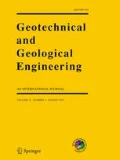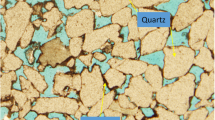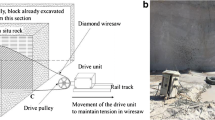Abstract
Penetration rate of rocks is influenced by geological parameters, machine parameters and operating parameters. This paper presents a study on the coarseness index (CI) and mean particle size (d) to evaluate the penetration rate (PR) in percussive drilling in a limestone and in a marl quarry. The coarseness index was determined from sieve analysis. The mean particle size (d) and specific surface area (SSA) were determined by using Rossin-Rammler-Sperling (RRS) graph for each hole samples. The relationships between PR and CI, d, SSA were investigated by regression analysis. The best lines were selected in these graphs. Reliable relations were found between penetration rate and coarseness index and mean particle size. Finally, it was seen that the coarseness index and mean particle size could be used in evaluating the penetration rate in percussive drilling operations.
Similar content being viewed by others
References
Altindag, R. (2003) Estimation of penetration rate in percussive drilling by means of coarseness index and mean particle size, Rock Mech. and Rock Engng., 36(4), 323–332.
Aytekin, Y. (1979) The measurement methods of fine particle, Ege Univ., Press No. 2, p. 114, (in Turkish).
Bilgin, N., Eskikaya, S. and Dincer, T. (1993) The performance analysis of large diameter blast hole rotary drills in Turkish coal enterprises, In: T. Almgren, T. Kumar and T. Vagenas (eds.), The 2nd Int. Symp. on Mine Mech. and Automation, Lulea, 129-135.
Ersoy, A. and Waller, M.D. (1997) Drilling detritus and the operating parameters of thermally stable PDC core bits, Int. J. Rock Mech. Min. Sci., 34(7), 1109–1123.
Howarth, D.F. and Rowlands, J.C. (1987) Quantitative assessment of rock texture and correlation with drillability and strength properties, Rock Mech. and Rock Eng., 20, 57–85.
Hustrild, W.A. (1971), The percussive drilling of quartzite, J. South. Afr. Inst. Mining Metall., 71(12), 245–270.
ISRM (1981) Rock Characterisation testing and monitoring, In: E.T. Brown (ed.), ISRM suggested methods, Pergamon, Oxford.
Kahraman, S., Balci, C., Yazici, S. and Bilgin, N. (2000) Prediction of the penetration rate of rotary blast hole drills using a new drillability index, Int. J. Rock Mech. and Min. Sci., 37, 729–743.
Miller, M. (1972) Normalisation of specific energy, Int. J. Rock Mech. Min. Sci., 9, 661–663.
Miranda, A. and Mello-Mendes, F. (1983) Drillability and drilling methods, In: Proceeding of the 5th Congress of the International Society of Rock Mechanics, Melbourne, 5, E195-200.
Paone, J., Madson, D. and Bruce, W.E. (1969) Drillability studies-laboratory percussive drilling, USBM RI 7300.
Pathinkar,A.G. and Misra, G.B. (1976) A critical appraisal of the Protodyakonov index, Int. J. Rock Mech. Min. Sci., 13, 249–251.
Pfleider, E.P. and Blake, R.L. (1953) Research on the cutting action of the diamond drill bit, Mining Engng., 5, 187–195.
Protodyakonov, M.M. (1962) Mechanical properties and drillability of rocks, In: Proceedings of the 5th Symposium on rock mechanics, Univ. Minnesota, May, 103-118.
Rabia, H.H.A. (1980) Effects of rock properties on the performance of down-the-hole drills, Unpublished Ph.D. Thesis, University of Leeds, 10.
Rabia, H. and Brook, W. (1980) An empirical equation for drill performance prediction, In: Proceedings of the 21st US Symposium on Rock Mechanics, Rolla, MO: University of Missouri, 103–111.
Roxborough, F.F and Rispin, A. (1972) The Mechanical Cutting Characteristics of The Lower Chalk, Univ. of Newcastle Upon Tyne.
Tandanand, S. and Unger, H.F. (1975) Drillability determination-A drillability index of percussive drills, USBM RI 8073.
Teale, R. (1965) The concept of specific energy in rock drilling, Int. J. Rock Mech. Min. Sci., 2, 57–73.
Author information
Authors and Affiliations
Rights and permissions
About this article
Cite this article
Altindag, R. Evaluation of drill cuttings in prediction of penetration rate by using coarseness index and mean particle size in percussive drilling. Geotechnical and Geological Engineering 22, 417–425 (2004). https://doi.org/10.1023/B:GEGE.0000025043.92979.48
Issue Date:
DOI: https://doi.org/10.1023/B:GEGE.0000025043.92979.48




